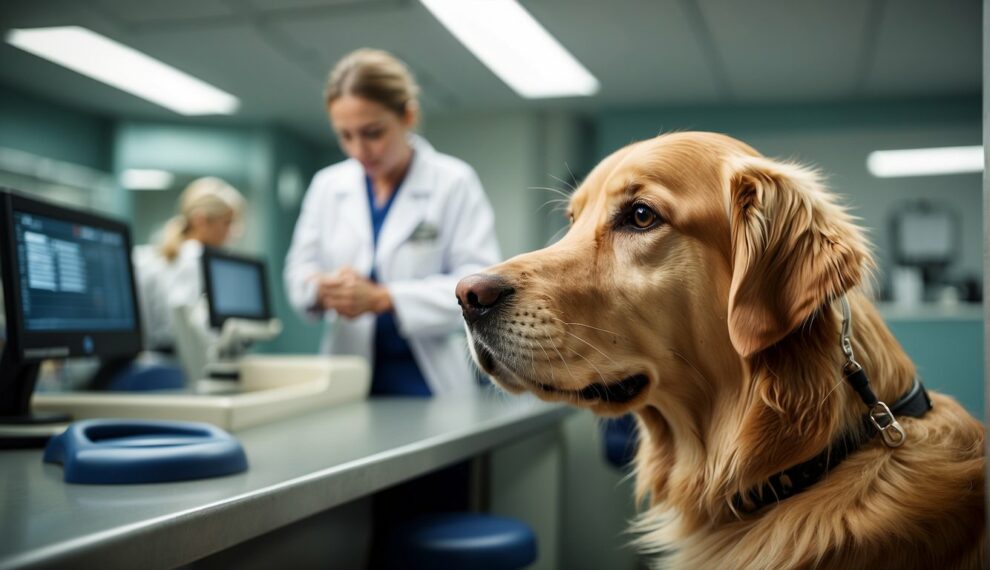A very common problem dog owners often face is the challenge of dealing with their furry friends’ ear infections, which can cause discomfort and pain for their pets.
These infections can stem from a variety of causes, including bacteria, yeast, or even allergies.
While it’s crucial to consult with a veterinarian for severe or persistent cases, there are several home remedies that may provide relief for milder infections and are worth considering as an initial approach.
Using natural ingredients found around the house, such as coconut oil and apple cider vinegar, can be gentle methods for addressing dog ear infections.
These ingredients possess properties like antifungal and antibacterial effects that may prove useful in mitigating some of the symptoms associated with the infections.
It’s essential, however, to be aware that even natural remedies can cause irritation for some dogs, so they should be used with caution.

When treating a dog’s ear infection at home, cleanliness and maintaining proper ear hygiene can go a long way in preventing and managing ear health issues.
Regularly checking their ears for signs of redness, odor, or discharge helps in early detection of problems, potentially making home treatments more effective.
Remember, these home remedies are not replacements for professional medical advice, but they can be helpful for minor infections and in preventing recurrence.
Identifying the Symptoms Of Ear Infections
Dogs typically show quite obvious signs when suffering from an ear infection.
They may frequently scratch their ears or shake their head in an attempt to alleviate discomfort.
Redness inside the ear, noticeable swelling, or an unusual odor emanating from the ear canal are telltale symptoms.
Discharge of varying colors such as brown, yellow, or bloody spots could also indicate an infection.
An owner might also observe their pet exhibiting increased itching or irritation in the affected ear.
When to See a Veterinarian
While home remedies might provide relief for minor issues, it’s crucial to know when professional veterinary care is required.
If a dog exhibits persistent symptoms despite initial home treatments, it should be taken to a vet.
Also, signs of severe pain, significant discharge, or odor should not be ignored.
Any swelling that expands to parts of the face or an infection that recurs soon after treatment are clear indicators that a veterinarian’s guidance is needed.
A proper diagnosis and treatment plan are essential for a dog’s health and wellbeing.
Causes and Prevention

When it comes to dog ear infections, understanding the root causes and implementing effective prevention strategies can make all the difference for a pet’s comfort and health.
Understanding the Root Cause
The root causes of ear infections in dogs typically stem from bacteria, yeast, or mites.
Conditions such as moisture in the ear can create an environment where these pathogens thrive.
Additionally, dogs may suffer from allergies—both food and environmental—which can lead to inflammation and secondary infections within the ear canal.
Key Factors in Prevention
To prevent ear infections in dogs, it’s crucial to maintain their overall ear health with regular cleaning and check-ups.
Here are some tips:
- Keep Ears Dry: After baths or swims, dry your dog’s ears thoroughly to prevent excess moisture.
- Manage Allergies: If allergies are a problem, work with a vet to address food allergies and control environmental allergens.
- Regular Cleaning: Use vet-approved cleaners to gently wipe away debris and maintain a healthy ear environment.
- Health Check: Regular vet visits can catch and treat issues like mites before they lead to an infection.
By staying vigilant and taking these preventative measures, one can significantly reduce the risk of ear infections in dogs.
Home Treatment Strategies

When tackling dog ear infections at home, it’s crucial to use safe cleaning methods and natural ingredients known for their healing properties.
Safe Cleaning Techniques
To properly clean a dog’s ear, one should first gently wipe the outer ear with a cotton ball or a soft cloth.
It’s important to never insert anything into the ear canal itself.
A solution of equal parts apple cider vinegar and water can be used for its antiseptic qualities—carefully applied with a sponge or syringe without a needle, taking care not to over-saturate the ear.
Essential steps for cleaning:
- Inspect the ear for any discharge, odors, or redness.
- Mix a cleaning solution, keeping in mind that gentler is better.
- Apply the solution to the outer ear with caution avoiding excessive moisture, which can lead to further irritation.
Natural Remedies and Ingredients
Many natural ingredients can aid in treating a dog’s ear infection.
For example, coconut oil, with its antifungal properties, can be warmed and applied to the ear to combat yeast.
Hydrogen peroxide is often mentioned, but due to its potential for irritation, it’s not commonly recommended for use in the sensitive ear area.
Instead, green tea infusions cooled to room temperature can be soothing alternatives.
A list of natural remedies include:
- Coconut oil: Apply a small amount to the ear for its antimicrobial benefits.
- Witch hazel: Known for skin healing, use sparingly.
- Oil of oregano: Dilute appropriately as it’s potent and might be too strong when used pure.
Medical Interventions

When a dog’s ear infection doesn’t improve with home remedies, it’s time to consider medical interventions.
Veterinary prescription medications can play a crucial role in treating more severe or persistent infections.
When to Use Medication
Medication becomes necessary when an ear infection does not resolve with initial home treatments or if the infection is severe.
A veterinarian should examine the dog to determine the presence of bacteria, yeast, or both, and may recommend either topical medication or oral antibiotics, depending on the diagnosis.
- Topical medication: Often the first line of treatment, especially for localized infections.
- Oral antibiotics: Prescribed when an infection has spread or is particularly stubborn.
Understanding Prescription Options
Prescription options can vary based on the underlying cause of the ear infection:
- Antibiotics: Used to treat bacterial infections.
- Anti-fungal medications: These are required if a yeast infection is present.
Medicines might be administered in the form of ear drops or ointment for topical medication or as tablets or liquid for oral antibiotics.
It’s important for pet owners to follow the veterinarian’s dosage instructions carefully to ensure the dog’s swift recovery.
Long-Term Ear Health
Managing long-term ear health in dogs is crucial to prevent chronic or recurrent ear infections, which can lead to hearing loss and permanent damage.
Consistency in ear care is key—they can’t slack off if they want their pups to stay happy and healthy!
Here’s a simple checklist to keep those floppy or pointy ears in tip-top shape:
- Regular Cleaning: Gentle, regular cleanings with a vet-approved solution can keep bad bacteria at bay.
- Dry Ears are Happy Ears: After baths or swims, they should make sure to dry their dog’s ears thoroughly.
- Diet Matters: A balanced diet supports overall health, which can prevent ear problems.
- Sniff & Inspect: They should get to know how their dog’s ears look and smell when healthy, so they can spot any changes early on.
When to See a Vet? 🏥
If they suspect a problem, they shouldn’t hesitate to seek veterinary care.
Early intervention can prevent treatable conditions from becoming dire.
Prevention Over Cure:
Maintaining a relationship with a vet helps nip potential issues in the bud.
Regular check-ups can catch the sneaky onset of ear trouble before the dog is shaking their head in discomfort.
Be Mindful of the Signs:
Chronic infections can sometimes sneak up on a pet.
Watch for signs like head shaking, pawing at ears, or any funky smells.
Catching recurring issues early can save a lot of grief and prevent permanent damage.
Remember, proactive ear care is a critical part of keeping their four-legged friend’s tail wagging and ears perky for the long haul.















